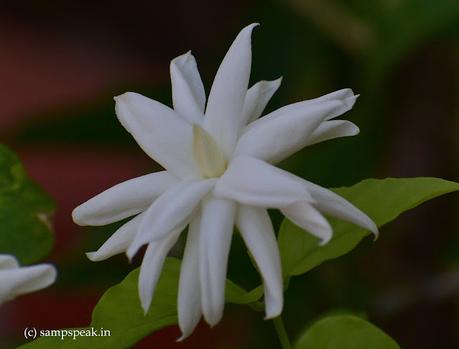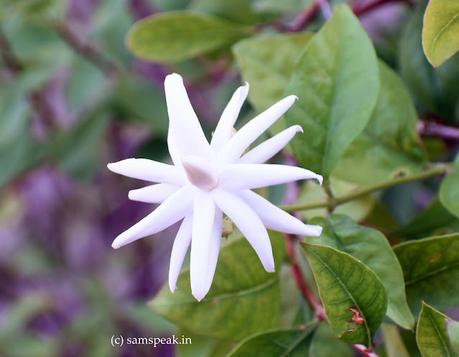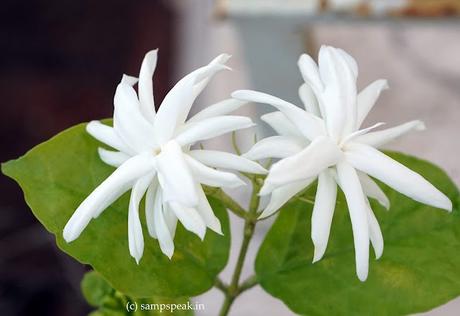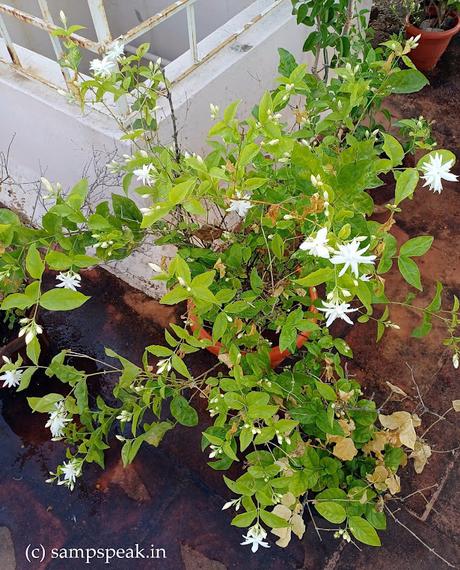Another day – a holiday at that and it dawned so beautifully – so happy in seeing so many of them in my terrace !! அனங்கம்என்றால் என்ன அறிவீரா !! : 1) உடலில்லாதது. அங்கமனங்கமான (incorporeal) 2) இருவாட்சி 3) மல்லிகை பூ. உருவம் என்பதை ‘இருக்கும் ஒன்று’ எனக் கொண்டால், அருவம் என்பதை ‘இல்லாத ஒன்று’ எனலாம்.

ஒச்சாயி ஒரு விதவை - கரிசல்பட்டி கிராமத்தில் பள்ளி படிப்பை பாதியில் நிறுத்திய அவளது மகன் வீரண்ணனோடு வாழ்ந்து வருகிறாள். ஒச்சாயின் பெண்ணுக்கும் மூக்கையா தேவருக்கும் பிறந்த மகள் முத்துப்பேச்சி. மூக்கையா தேவருக்கு ஹம்சவல்லி என்ற பெண்ணுடன் தொடர்பு உள்ளது. முத்துப்பேச்சிக்கு தன் மாமன் மீது ஆசை !! - அவர்கள் குடும்பத்தில் நிலத்தகராறு காரணமாக பேச்சு வார்த்தை இல்லை !!
பொத்தி வச்ச மல்லிகை மொட்டு, பூத்திருச்சு வெக்கத்த விட்டு
பேசிப் பேசி ராசியானதே, மாமன் பேரைச் சொல்லிச் சொல்லி ஆளானதே
ரொம்ப நாளானதே
பாரதிராஜாவின் இயக்கத்தில் 1983ம் ஆண்டு வெளிவந்த படம் மண்வாசனை - புதுமுக நடிகர்கள் பாண்டியன், ரேவதி மற்றும் பலர் நடிக்க, இளையராஜா இன்னிசை தந்தது இப்படத்தை வெற்றிப்படமாக்கியது. இப்படத்தில் மேற்கண்ட சிறப்பான பாடல் பட்டிதொட்டியெங்கும் ஒலித்தது :
Incorporeality is "the state or quality of being incorporeal or bodiless; immateriality; incorporealism." Incorporeal - means "Not composed of matter; having no material existence”.
Incorporeality is a quality of souls, spirits, and God in many religions. In ancient philosophy, any attenuated "thin" matter such as air, aether, fire or light was considered incorporeal. The ancient Greeks believed air, as opposed to solid earth, to be incorporeal, insofar as it is less resistant to movement; and the ancient Persians believed fire to be incorporeal in that every soul was said to be produced from it. In modern philosophy, a distinction between the incorporeal and immaterial is not necessarily maintained: a body is described as incorporeal if it is not made out of matter.
In the problem of universals, universals are separable from any particular embodiment in one sense, while in another, they seem inherent nonetheless. Aristotle offered a hylomorphic account of abstraction in contrast to Plato's world of Forms. Aristotle used the Greek terms soma (body) and hyle (matter, literally "wood").
"In Ayurveda, it is known as 'Hrudhya Gandha', which means 'fragrance pleasing to the heart'. It is a cooling herb. For sure you love them – they come ‘dime a dozen’ and there are so many varieties. Here is one grown in our terrace ! -


அடுக்கு மல்லிகை - இருவாட்சி மல்லிகை! சிரியா நாட்டில் உள்ள டமாஸ்கஸ் நகரின் குறியீட்டு மலர் மல்லிகை. இந்தியாவில் மல்லிகை என்றாலே மதுரை. மதுரை என்றாலே மல்லிகைதான். மல்லிகைச் செடியா? கொடியா? - இரண்டும்தான். மல்லிகை ஆலிவ் குடும்பமான ‘ஒலிசியே’ எனும் புதர் மற்றும் கொடிகள் சார்ந்த பேரினம். ‘ஜாஸ்மினும் சம்பக்’ (Jasminum Sambac) எனும் தாவரவியல் பெயரால் அழைக்கப்படும் மல்லிகை, இந்தியா, ஸ்ரீலங்கா, தாய்லாந்து, மியான்மர் நாடுகளில் காணப்படும் மலரினமாகும்.
The biggest difference between jasmine varieties is their growth habit. The most well-known types are vines, especially Jasminum polyanthum. Given our love affair with jasmine, it's no surprise that this flower finds several mentions, from being used to decorating the hair or being added to earthen pots of water to quench thirst. The Layered Jasmine plant is a deciduous shrub native to Asia, it produces stunning flowers that have ornamental and commercial values.
Jasminum sambac (Arabian jasmine) is a species of jasmine native to tropical Asia, from the Indian subcontinent to Southeast Asia. It is cultivated globally. Jasminum sambac is a small shrub or vine growing up to 0.5 to 3 m (1.6 to 9.8 ft) in height. It is widely cultivated for its attractive and sweetly fragrant flowers. The flowers may be used as a fragrant ingredient in perfumes and jasmine tea. It is the national flower of the Philippines, where it is known as sampaguita, as well as being one of the three national flowers of Indonesia, where it is known as melati putih.
Jasminum sambac is classified under the genus Jasminum under the tribe Jasmineae. It belongs to the olive family Oleaceae. The English common name of "Arabian jasmine", Jasminum sambac is due to it being widely cultivated in Southwest of Saudi Arabia, Yemen and Oman. The Medieval Arabic term "zanbaq" denoted jasmine flower-oil from the flowers of any species of jasmine. This word entered late medieval Latin as "sambacus" and "zambacca" with the same meaning as the Arabic, and then in post-medieval Latin plant taxonomy the word was adopted as a label for the J. sambac species. In 1753, Carl Linnaeus first described the plant as Nyctanthes sambac in the first edition of his famous book Systema Naturae. In 1789, William Aiton reclassified the plant to the genus Jasminum. He also coined the common English name of "Arabian jasmine".

Very happy to see a bunch of them this morning in my terrace !
With regards – S Sampathkumar21.4.2024

